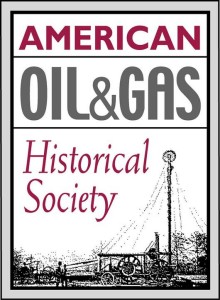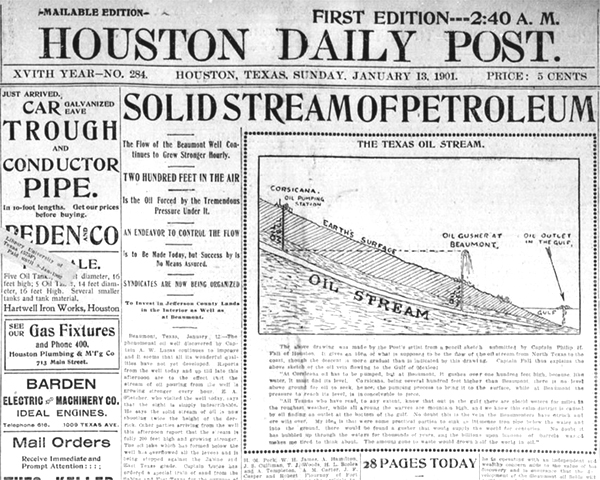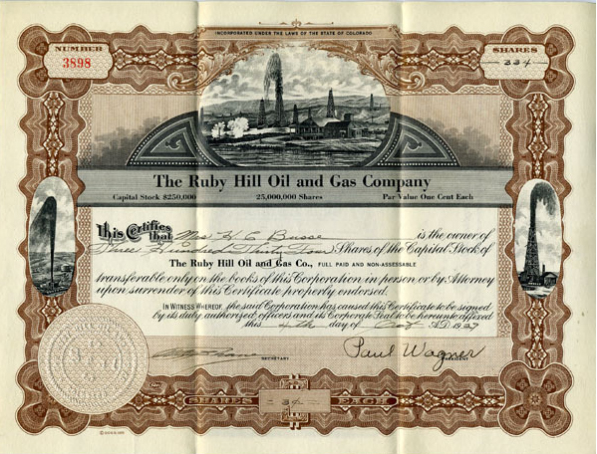There’s not much of a chance of discovering financial information here in Old Oil Stocks – in progress “R” that will lead to lost riches – see Not a Millionaire from Old Oil Stock. The American Oil & Gas Historical Society needs support, and does not have resources to provide free research.
However, AOGHS continues to look into forum queries as part of its energy education mission. Some investigations have revealed little-known stories like Buffalo Bill’s Shoshone Oil Company; many others have found questionable dealings during booms and epidemics of “black gold” fever like Arctic Explorer turns Oil Promoter.
Visit the Stock Certificate Q & A Forum and view company updates regularly added to the A-to-Z listing at Is my Old Oil Stock worth Anything? AOGHS will continue to look into forum queries, including these “in progress.”
Railroad Employees Oil Company
In August 1951 the Stephens County district court clerk announced that among other absentee enterprises, Railroad Employees Oil Company was being sued (Case Number 14,886) and ordered to appear in court. “Defendants have been absent from Stephens County and the state of Texas for more than five years,” the suit alleged. “Defendants have not paid any taxes on the mineral interest.”
The many plaintiffs in the case, sought to have a receiver appointed, “for the purpose of selling, executing and delivering an oil and gas lease covering the undivided mineral interest of said Defendants.” The Texas Railroad Commission should have more information on the Railroad Employees Oil Company.
Railroaders’ Oil Company
Railroaders’ Oil Company, Railroaders’ Gas Company, and Railroaders’ Oil & Gas Company all appear to be variants of the same company. In 1920 Railroaders’ Oil was organized in Louisville, Kentucky, capitalized at $2 million. Officers were: T.J. Heaton, president and J.J. O’Malley, both of Milwaukee, Wisconsin. Oil exploration operations were soon underway in along the Ohio River in Harrison County, Indiana, with more than 30,000 acres under lease.
By June 1921 Railroaders’ Oil had drilled five successful gas wells and was negotiating to provide natural gas from the Laconia field to New Albany, about 25 miles distant. National Petroleum News reported in 1926 the company – now called Railroaders’ Oil & Gas Company – “has about 50 gas wells in the southern part of the county and are drilling more.”
By 1928 Railroaders’ Oil & Gas had 40 wells in the Laconia field (Tobacco Landing and Dogwood areas) and the New Middleton field. But when Kentucky Pipe Line Company (an auxiliary of Louisville Gas & Electric) declined to buy its daily quota of natural gas for the city of Louisville, litigation ensued. Dry holes, pipeline costs and onset of the Great Depression then forced the company, by now known as Railroaders’ Gas Company, into bankruptcy and receivership. It was absorbed by the Indiana Utility Corporation in 1929.
Ramsey Oil Company
Both Ramsey Oil Company and Pecos Natural Oil Company pursued oil in West Texas, circa 1917 to 1925. Wells were drilled in the vast Permian Basin, in sparsely populated Loving County, 120 miles west of Midland (and about 40 miles from today’s Million Barrel Museum in Monahans). Loving County remains the least populous county in the United States.
Wildcatters James Jackson “J.J.” Wheat Sr. and Bladen F. Ramsey had earlier formed Toyah Bell Oil Company (1920), which became Ramsey Oil. The El Paso Herald reported Pecos Natural Oil’s interest in a Toyah Bell exploratory well in Pecos County. In 1921 Toyah Bell Oil spudded two wells in Loving County. With a showing of oil at their first well, the No. 1 L.B. Russell, and a second well (No. 2 Russell) underway, Toyah Bell Oil changed its name to Ramsey Oil.
Ramsey Oil contracted to sell oil to El Paso’s Rio Grande Oil & Refining Company for three dollars per barrel. The Oil Trade Journal called the Ramsey well, “one of the most promising wildcats anywhere in Texas” and noted that it had “stimulated wildcatting activities throughout the Pecos region.”
Despite its promising beginnings, the No. 1 L.B. Russell well’s casing collapsed in 1922 and the well could not be saved. It was shut down at 4,485 feet and never completed as a producing well. “Because of bad casing and improper drilling, it was abandoned in 1925,” noted the Bureau of Economic Geology.
Bad luck continued in 1923 when the Russell No. 2 well was capped at 705 feet deep without finding oil. Wheat and Ramsey sold out to Pecos Valley Oil Company and Ramsey Oil Company disappeared. In 1925, Pecos Valley Oil drilled a mile south of Ramsey Oil’s abandoned No. 1 L.B. Russell well – and completed Loving County’s first commercial producer, the No. 1 Wheat, opening the Wheat oilfield.
Pecos Valley Oil became part of Sinclair Prairie Oil Company. Production from the Permian Basin’s Wheat oilfield peaked in 1931 at more than 1.2 million barrels of oil. Although Ramsey Oil Company did not survive, the town it helped to create the town of Ramsey, named after oilman Bladen F. Ramsey. Now renamed Mentone, it remains the county seat of Loving County.
Ranger and Burkburnett Oil Company
Henry H. Hoffman was president of the Ranger and Burkburnett Oil Company, capitalized at $500,000. In 1921 he was sued by company stockholders. They soon objected to “the much discussed question of a promoter accepting blocks of stock in exchange for leases” in order to manipulate stock prices.
Shareowners alleged that leases, “costing Hoffman but little, were sold in the company for considerable blocks of stock.” Stockholders sought appointment of a receiver, a verdict of $250,000 in damages against Hoffman, and cancellation of documents that gave him 275,000 shares of Ranger & Burkburnett Oil.
Ranger-Vindicator Oil & Development Company
As North Texas continued to experience a drilling boom, in 1922 the Ranger-Vindicator Oil and Development Company drilled its Thornton No. 1 well to a depth of 3,300 feet in Navarro County. Water intrusion ruined the well, about two miles west of Wortham. It apparently was not followed by any successful attempts. Two years later another company struck a gusher (the Roy Simmons No. 1) revealing an oilfield that produced three million barrels of oil by 1925.
Red Rock Oil & Gas Company
In 1917 Investment Weekly reported Red Rock Oil and Gas Company to be “an excellent purchase for early speculative profits.” The company had incorporated in Oklahoma and issued 150,000 shares of stock (par value $1) in order to develop leases acquired in Neosho County, Kansas (160 acres); the Bixby oilfield, Oklahoma (80 acres); and Tulsa County, Oklahoma (80 acres).
These Mid-Continent field leases were near areas of proven production. Many nearby wells yielded both oil and natural gas. With producing zones ranging from 800 feet deep to 900 feet deep, drilling costs were about $1.25 per foot, according to Investment Weekly. The trade publication predicted the value of Red Rock Oil & Gas stock would sharply advance when the company brought in its first well, noting, “The unusual features of low capitalization, and evident early production are undoubtedly attracting attention to this (stock) issue.”
The Investment Weekly prediction did not pan out. Red Rock Oil and Gas drilled in Colorado and Louisiana as well as Kansas and Oklahoma. It was still a viable company in 1921 – but by then its stock sold on the New York curb market for about 75 cents a share. Investment Weekly’s enthusiasm waned.
“We do not believe that the prospects of Red Rock Oil & Gas Company, even as a speculation are particularly bright at this time,” the editors concluded. In 1922 the company had some modest success in Louisiana’s Webster Parish, but seems to disappear from financial records soon thereafter. A March 1905 oil discovery at Caddo-Pines near Shreveport had brought wildcatters to northern Louisiana. A museum in Oil City today tells the story.
Richey Oil Company
Richey Oil Company, a Montana corporation, formed in January 1952. Its founders may have been inspired by a Shell Oil Company oil discovery six months earlier near Richey, in Dawson County. Shell Oil’s wildcat well produced 1,400 barrels of oil a day from about 7,250 feet deep.
The 1951 Shell Oil discovery well was the first commercial oil found in the Montana portion of the humongous Williston Basin (a portion that produced 868,595 barrels of oil per day in 2015). The petroleum-rich basin had been revealed earlier that year by North Dakota’s first oil well.
The Shell Oil discovery prompted a rush of exploration companies to the county, including Richey Oil, which secured a lease in adjacent Richland County. On May 5, 1952, Richey Oil spudded its Otis Waters No. 1 well. Mr. Waters was the mayor of Richey. On June 25 the Helena, Montana, Independent Record reported bad news.
“The Richey Oil company’s drill stem test at its wildcat well seven miles east of Shell’s original discovery in the Montana part of the Williston basin was ‘a fizzle,’ Secretary-Treasurer John Whiteman of Richey reports,” the newspaper noted. The well had reached a total depth of 7,565 feet before being given up as a dry hole. Plugged and abandoned in accordance with state regulations, the documents close with, “Welded Steel Plate Over Surface Pipe.”
Montana secretary of state records show that Richey Oil Company was “Involuntarily Dissolved,” which usually means a dissolution carried out through a court ruling. Creditors often seek a judicial resolution because of non-payments…or fraudulent activities by the directors.
Rockefeller Oil Company
On January 10, 1901, an oil gusher at Spindletop launched the modern petroleum industry and led to the founding of many new petroleum companies. Most did not survive long.
 As newspapers everywhere published stories about the “black gold” found near Beaumont, Texas, Rockefeller Oil Company was chartered on April 23, 1901, capitalized with $200,000.
As newspapers everywhere published stories about the “black gold” found near Beaumont, Texas, Rockefeller Oil Company was chartered on April 23, 1901, capitalized with $200,000.
The Spindletop oilfield soon produced more oil in one day than all the rest of the world’s oilfields combined. In its first year alone, Spindletop produced 3.59 million barrels of oil – climbing to 17.4 million by its second year. Unfortunately for many companies and their investors, the unregulated oil production caused prices to drop from $2 per barrel to less than 25 cents per barrel.
Although Texaco, Gulf, Mobil and Sun oil companies can trace their roots to Spindletop and its nearby oilfields, hundreds lesser funded speculative ventures failed to survive. Oilfield service companies like Beaumont Confederated Oil & Pipeline Company also suffered. On November 30, 1901, United States Investor reported, “The Rockefeller Oil Co. is little known and as it owns no Spindle Top property, we do not think much of it.” On May 6, 1903, Rockefeller Oil Company’s charter do business was revoked by Texas “for nonpayment of franchise taxes.”
Rosson Oil Company
Along the Red River in North Texas, Wichita Falls grew explosively after the opening of the vast Burkburnett oilfield in June 1918. Within three weeks, 56 drilling rigs were at work as close as they could get to the discovery well. Entrepreneurs scrambled to get in on the opportunity.
The “World’s Wonder Oilfield” spawned many new oil companies as Wichita Falls bank deposits grew by 400 percent in 1919. There were nine refineries and 47 factories within the city limits by 1920. Oil companies cultivated investors to get money to drill a producing well before the inevitable exhaustion of the field.
 Rosson Oil formed in early 1919 largely funded with investors’ money. By May 1919 its first well in the Burkburnett field (Van Cleave lease) reached 1,800 feet deep without striking oil – a dry hole, which often proved lethal to any under capitalized business. Rosson Oil sold stock to fund drilling and went broke after failing to find oil.
Rosson Oil formed in early 1919 largely funded with investors’ money. By May 1919 its first well in the Burkburnett field (Van Cleave lease) reached 1,800 feet deep without striking oil – a dry hole, which often proved lethal to any under capitalized business. Rosson Oil sold stock to fund drilling and went broke after failing to find oil.
Ruby Hill Oil & Gas Company
Ruby Hill Oil & Gas Company stock was promoted at five cents per share in 1930 and the company drilled near Denver, in 1934. Its No. 1 Braden well in Jefferson County, stalled for a year – then resumed “making hole” in 1935.
The company apparently failed, as its stock certificates are valued only by collectors for their artistic and historic value.
The stories of exploration and production companies joining petroleum booms (and avoiding busts) can be found updated in Is my Old Oil Stock worth Anything? The American Oil & Gas Historical Society preserves U.S. petroleum history. Please support this AOGHS.ORG energy education website. For membership information, contact bawells@aoghs.org. © 2020Bruce A. Wells.

